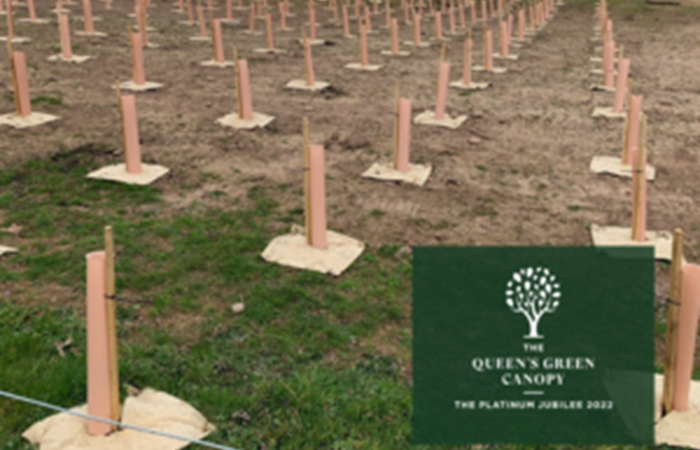Environment Agency

- Over 2 hectares of broadleaf woodland will transform a former landfill
- The Queens Green Canopy initiative saw 225 trees planted on site
The Lower Otter Restoration Project (LORP) in Budleigh Salterton, Devon, is celebrating another key step ahead of its completion later this year, with over 23,000 saplings now planted across the site as part of the work.
Of these trees, 225 were planted as part of the Queens Green Canopy scheme, which was launched last year to leave a legacy for the late Queen Elizabeth II.
A significant proportion of this planting is located on the former domestic tip site, which has been raised to enable it to be reclaimed by nature and become a pleasant green spacefor the community and visitors.

The site of the former domestic tip, now covered with young trees
Earlier this month, Simon Jupp, MP for East Devon, joined Andrea Ayres, Operations Manager at the Environment Agency, to plant a tree on the tip site, view the projects progress, and celebrateWorld Planting Day.
Species planted include a mix of canopy species trees and understory shrubs and small trees such as field maple; silver and downy birch; crack, grey, goat and white willow; guelder and dog rose; crab apple; wild cherry; hawthorn; blackthorn; hornbeam, and pedunculate and sessile oak.
New hedgerows have also been planted, and other existing hedgerows have been thickened and improved. This helps improve connectivity through the landscape for wildlife such as dormice and birds that rely on them for refuge, and bats that use them to navigate.
Trees and hedgerows provide many benefits: they create vital habitat for small mammals, birds and insects; increase local biodiversity; lock-in carbon, and contribute to improving human health and wellbeing, especially where they are associated with recreational access.
LORPs extensive planting scheme continues to create more woodland and offsets the removal of some mature trees earlier in the project.
Vegetation was initially cleared to provide the open estuarine habitat necessary to attract waders and other key bird species (wading birds need far-reaching views to enable them to be able to feed without being predated). Vegetation has also now effectively been relocated to areas around the site where it will not be adversely affected by saltwater re-entering the historic floodplain or snag debris.
Dan Boswell of the Environment Agency said:
This is another big step forward for the project and our efforts to restore the Lower Otter Valley to a more natural state. The planting addresses some of the ecological and environmental challenges we have in the area and will play an important role in enhancing local biodiversity and visitors experiences.
It is early days, but the Lower Otter Restoration Project is already having clear positive effects on the valleys ability to attract more and more varied birdlife, and as these saplings grow and the newly restored wetlands develop, this will greatly increase.
The Lower Otter Restoration Project is an intertidal habitat restoration project delivered by the Environment Agency in partnership with the East Devon Pebblebed Heaths Conservation Trust and Clinton Devon Estates. It is part of a cross-border initiative called Promoting Adaptation to Changing Coasts (PACCo) and is delivering climate change adaptation by working with nature to provide benefits for people and the environment.
Work includes a 70-metre breach in embankments to reconnect the Otter Estuary to its historic floodplain; restoring 55 hectares of wetland habitat; the construction of a 30-metre span flood resilient, raised road and road bridge, as well as a new footbridge over the location of the future breach to ensure continuity of the South West Coast Path; the relocation of Budleigh Salterton Cricket Club away from the floodplain; raising and improving public footpaths, and creating wildlife viewing areas.
To find out more about the Lower Otter Restoration Project, visit: www.lowerotterrestorationproject.co.uk.
For more information on the PACCo initiative, visit: www.pacco-interreg.com.
Background
The LORP project is the English arm of the Anglo-French venture Promoting Adaptation to Changing Coasts (PACCo). It has been majority funded by the UK government, with 8.5 million of co-financing from the European Regional Development Fund (ERDF) through the Interreg V A France (Channel) England programme (2021 to 2023). As part of the initiative, work is also going ahead on a similar project i
